Meet our Investigators: Beth Stevens, PhD
How long have you been a member of the IDDRC? Which organization and department do you work for?
I became a member of the IDDRC in 2008. My laboratory is in the FM Kirby Neurobiology Center at Boston Children’s Hospital, Department of Neurology.
What is the main focus of your research?
Our research is focused on understanding how neural-immune interactions in the brain sculpt synapses during normal development and how this process can go awry in disease. We discovered that microglia, the brain’s resident immune cells, prune neural connections in response to signals from the classical complement pathway, a branch of the immune system. We uncovered a diverse set of immune molecules that regulate this process in the brain during normal development, providing insights into how the brain forms and refines circuits in health and disease. Some of these same immune molecules can also become misregulated in disease, leading to pathological synapse loss in Alzheimer’s disease, dementia, and schizophrenia. We are trying to understand the complex cross talk between neurons, glia and immune cells in these different contexts. To be able to address these questions, my lab is deeply interdisciplinary, integrating across the fields of genetics, immunology, and neuroscience. We believe that combining knowledge and techniques from disparate fields will lead to an understanding of how neural-immune interactions regulate circuit formation and function, leading to a better understanding of behavior.
What led you to pursue research career and/or interest in IDD?
I began studying glial cells as a research assistant and PhD Student with Douglas Fields at the National Institutes of Child Health and Development (NICHD) at the NIH. This is where my passion for developmental neuroscience and glial biology blossomed. In 2004, I followed my interests in glial biology and was fortunate to do my postdoctoral training with Ben Barres at Stanford University, a pioneer in the glial field and an outstanding mentor who inspired his trainees to ask big questions and challenge dogma. At the time neuroscientists had begun thinking of glial cells as active communicators between the brain’s nervous and immune systems. For example, we discovered that, in a healthy, developing brain, a group of secreted immune molecules called complement mark young synapses for elimination.
After establishing my own lab at Boston Children’s Hospital, I pursued the hypothesis that microglia – resident immune cells in the brain – might be involved in pruning the plethora of synapses we have in our gray matter during postnatal development, following directions from complement and other immune molecules that provide instructive cues to microglia and other glial cells.
We found that microglia sculpt developing neural circuits and that many of the molecules that regulate synaptic pruning and microglial function are shared between the nervous and immune systems. We also found that these developmental pruning mechanisms can go awry early in disease and contribute to synapse loss and cognitive phenotypes in models of Alzheimer’s. We have developed new models and approaches to study immune related mechanisms relevant to schizophrenia, autism and other neurodevelopmental disorders. Our hope is that some of these mechanisms could lead to new therapeutic targets and biomarkers for early detection and tracking of disease progression.
Any comments on the services of a core/or particular equipment that advances your current research?
We have benefited tremendously from access to the confocal microscopes and image analysis workstations offered by the IDDRC Cellular Imaging Core at Children’s Hospital – it is an affordable, efficient and state-of-the-art shared facility. For example, we use IDDRC’s imaging and analysis capacity to localize molecules of interest, such as the complement proteins to quantify changes in synapse features and density across a range of experimental conditions. This includes both mouse brains — e.g. quantifying changes in retinal synaptic inputs to the early postnatal thalamus, a system we use as a model of developmental synaptic pruning — and human postmortem brain samples to quantify synapse loss from patients with neurological diseases. In addition, reliably quantifying engulfment of synapses by microglia in situ in brain tissue requires 3- or 4-channel confocal 3D imaging and reconstructions of microglia, their lysosomal compartments, and the synaptic material contained within. This method relies heavily on the imaging core’s hardware and software.
Are you interested in collaborating or offering any collaborative opportunities? If yes explain briefly.
Yes, I have a great appreciation for the enormous benefit of collaborations! We have had many effective partnerships and scientific collaborations over the years with multiple IDDRC labs and beyond. Interdisciplinary collaborations and sharing of data, ideas and tools have resulted in new discoveries and unexpected scientific directions. Bringing scientists together who share different perspectives and expertise is also a fun and rewarding part of being a scientist in this amazing community.
Something fun/personal: interesting tidbit about you: favorite place to travel, pet, hobby, talent, funny story
I am passionate about science but also about my coffee. As my colleagues and trainees know, I am a caffeine addict (~10 cups /day!) and a bit of a coffee snob. This all started in the Barres Lab and was inspired by Ben who used to roast his own beans that he ordered from all over the world. He would make these amazing blends of Arabian Mocha Java, Ethiopian, and other exotic blends and hand them out to sample and critique at every lab meeting. Roasting coffee is a science that takes a lot of experimenting to perfect– a wonderful tradition and hobby I hope to develop and share.



